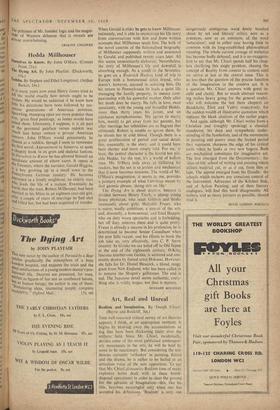Art, Real and Unreal
Realism and Imagination. By Joseph Chiari. (Barrie and Rockliff, 30s.)
This well-reasoned critical survey of art theories appears, I think, at an appropriate moment. It begins by blowing away the accumulations of fog that have been thickening lately over the ;esthetic field. Since Mr. Chiari, incidentally, derides some of the most publicised contempor- ary movements in the arts, he will be held by some to be reactionary. But considering the ten- dencies currently 'orthodox' in painting, fiction and the drama, he is rather to be hailed as an articulate voice of the new opposition. To say that Mr. Chiari dismantles Realism (one of many explosive terms dealt with in these bomb- disposal operations) in order to clear the ground for the advance of Imagination—this, like his title, becomes meaningful only when one has accepted his definitions. 'Realism' is only one
dangerously ambiguous word freely bandied about by art and literary critics, now as a synonym, now as an antonym, of the word 'naturalism'; and in either case having little in common with its long-established philosophical meaning. The whole current coinage of xsthetics has become badly debased; and it is no exaggera- tion to say that Mr. Chiari spends half his chap- ters clarifying this single problem, chasing the concept of Reality from context to context until we arrive at last at the central issue. This is no less than the question of the precise function of the imagination in the creative act. It is a question Mr. Chiari answers with great in- sight and clarity. But so much abstract reason- ing makes heavy going for the general reader, who will welcome the last three chapters on Baudelaire, Eliot and Valery respectively, for the sudden wealth of illustrative quotation which replaces the bleak citations of the earlier pages.
And again, although Mr. Chiari writes from a Christian and (roughly speaking) a classical standpoint, his deep and sympathetic under- standing of the Symbolists, and of the movements in painting and poetry since the fecund period they represent, sharpens the edge of his critical knife when he looks at two new bogeys. Both are mechanical substitutes for imaginative art. The first emerged from the Documentary: the 'slice-of-life' school of writing and painting which utilises material cut, or as if cut, from film or tape. The second emerged from the Doodle: the schools w hich eschews any conscious control of the instrument. Advocates of the Kitchen Sink, and of Action Painting, and of their literary analogues, will find this book disagreeable. All writers, and as many painters as possible, should read it.
HUGH GORDON I'ORTEUS


































 Previous page
Previous page